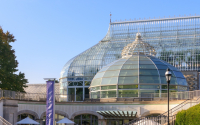Challenge 3
Welcome to the middle school challenge page for Challenge 3 of the Fairchild Challenge! Read below to find challenge information, entry requirements, resources and more for the challenge.
Challenge 3: Media-Journalism
Title: "In the Field"
For groups or individuals
Due: Fri., Jan. 9, 2026 by 5 p.m.
Download the Challenge 3 Rubric
Your Challenge:
Like a reporter in the field, it is your turn to take on the role of an interviewer and explore how your peers connect with the natural world. Your mission is to ask meaningful questions and have real conversations that uncover what your classmates care about when it comes to nature. What inspires them? How do they spend time outdoors? Why does the environment matter to them? Through these interviews, you’ll practice skills like active listening, curiosity and empathy all while learning how others experience and value the world around them.
Once your interviews are complete, you’ll turn them into a short audio or visual story. This could be a podcast, a “hallway-style” interview, a mini documentary or a sit-down conversation—whatever format best brings your story to life. The goal is to capture honest voices and real perspectives, and to use those stories to inspire others to appreciate and explore the natural world. This project is about more than just interviews. It’s also about connecting people through storytelling, building awareness about our environment and finding new ways to enjoy and protect the planet we share.
In addition to your video or podcast, please submit a brief 1–2 page reflection discussing and interpreting the conversations you had, how it felt to speak to your peers about the environment and 3 major similarities or differences you noticed across your interviewees’ responses. Videos/podcasts should be between 5-7 minutes in length. We suggest uploading your video on YouTube as an unlisted video or uploading it to a Google Drive folder. Share the link with us by copying it and pasting it into a Word Doc. Be sure to include a list of resources you used.
Entry Requirements: Submit up to 2 entries to the science education coordinator at Phipps via electronic submission to amule@phipps.conservatory.org:
- Challenge Entry Form, include the school name and the participating students’ names.
- One of the following audio/visual submissions:
- Podcast (5–7 minutes)
- Short video (5–7 minutes)
- Other 5–7 minute audio/visual option
- Work sited
School Submits: Challenge Entry Form, Video, Work Cited
Resources: The following list of online resources may be used when preparing your entry.
- Lesson 2.2: Interviewing: The Art of Asking Questions - PBS News Student Reporting Labs - PBS News Student Reporting Labs
- How to Help Students Develop Interviewing Skills | Edutopia
- SLB Radio Homepage - SLB Radio
- How to speak with your family and friends about environmental issues » Yale Climate Connections
- Exploring the beliefs and perceptions of spending time in nature among U.S. youth | BMC Public Health | Full Text
Standards
Read below to find the standards for each grade level for Challenge 3 of the Middle School Fairchild Challenge
- 4.5.6.D Identify reasons why organisms become threatened, endangered, and extinct.
- 3.4.6-8.A Students who demonstrate understanding can develop a model to describe how agricultural and food systems function, including the sustainable use of natural resources and the production, processing, and management of food, fiber, and energy.
- 3.4.6-8.D Students who demonstrate understanding can gather, read, and synthesize information from multiple sources to investigate how Pennsylvania environmental issues affect Pennsylvania’s human and natural systems.
- 3.4.6-8.H Students who demonstrate understanding can design a solution to an environmental issue in which individuals and societies can engage as stewards of the environment.
- 3.4.6-8.I Students who demonstrate understanding can construct an explanation that describes regional environmental conditions and their implications on environmental justice and social equity.
- 9.1.8.C Identify and use comprehensive vocabulary within each of the arts forms.
- 9.1.8.E Communicate a unifying theme or point of view through the production of works in the arts.
- 9.1.8.K Incorporate specific uses of traditional and contemporary technologies in furthering knowledge and understanding in the humanities.
- 15.3.8.E Choose appropriate print and electronic resources to meet project need.
- Reference English Language Arts CC.1.4.8.U
- 15.3.8.G Develop appropriate information and content for presentations, meetings, discussions, and group assignments.
- Reference English Language Arts CC.1.5.8.A, CC.1.5.8.D
- 15.3.8.H Deliver presentations using a variety of techniques and media; employ conventions of language.
- Reference English Language Arts CC.1.5.8.E, CC.1.5.8.G
- 15.3.8.J Identify barriers to active listening (e.g., environmental, peer, time, and cultural distractions).
- 15.3.8.P Describe leadership communication skills necessary for goal setting and generating ideas.
- 15.3.8.X Demonstrate effective techniques for good communication.
- 15.4.8.A Analyze the influence of emerging technologies on daily life.
- 4.5.8.C Describe how humans can reduce pollution.


